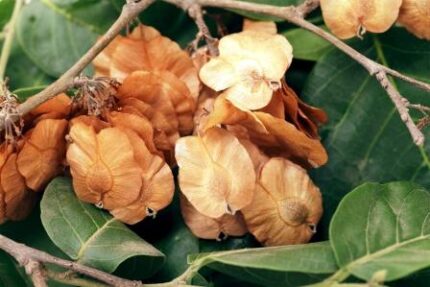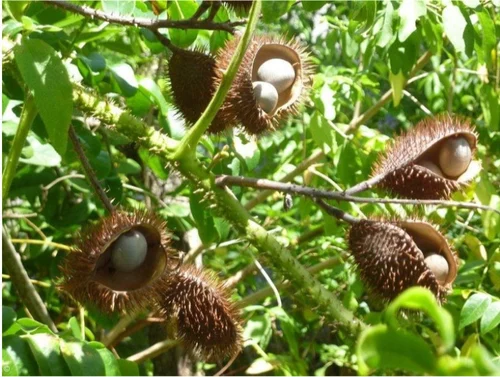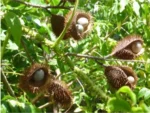Latakaranja or kantaki-karanja is the third variety of karnaja quoted by madanapala. Susruta used its other synonym kuberaksi for the first time (S.S.Su.39/6 & Ut.35/3). But Thakurji considered kuberaksi of susruta may be svetamoksaka (Schrebera swietenioides Roxb.). The descriptions of Sveta-Mokshaka and Mokshaka are observed in S.S.Ci.4/32 and S.S.Ka.3/9; S.S.Ut. 44/29 respectively. Some consider Mushkaka in place of Mokshaka. However, it is generally accepted that C. bonduc is the source of latakaranja.
Putika or Atika terms are found in the vedic literature. It is described in connection with ‘Soma’ and in fact described as the substitute for Soma. Some commentators considered this plant as a grass (Trna) while others accepted it as a creeper akin to soma. P.V. sharmaji identified it with Caesalpinia bonducella (C. crista). Though its description appears to be involved with some controversy in the Samhitas, Nighan¢us and yoga granthas praised its utility in therapeutics.
CCRAS made its seed powder as one of the important ingredients in Ayush-64 (a drug evaluated for malaria). The name Kuberaksha is more popular today hence the preparation Kuberakshavati. It is an effective remedy for acute pain abdomen (anti-spasmodic), malarial fever, irritable bowel syndrome (as reported by Dr. K. Nisteswar) and other conditions. Folk-lore apply its leaf paste or seed paste over hydrocele which reduces the srutal swelling effectively.
Different varieties– As already described in the context of latakaranja it is one among the three varieties of karanja described by Bhavamishra.
Botanical Description– It is a large scandent prickly shrub. Branches- small, yellow, covered with downy prickles. Leaves- bipinnate; leaflets 12-16, elongated, upper part thick. Flowers- long peduncle bearing dense flowers at the top. Fruits- pods, prickly, wingless, swollen in the middle and slightly flat. (Flowers during rainy season and fruits during winter).
Discription– Throughout the hotter parts of India. Common in west Bengal and South India.
Major chemical constituents– Seeds- L-r-ethylideneglutamic acid and amino acids; caesalpins; caesalpin-F bonducelline etc.
Part Used– Root bark, leaf, seeds.
Dosage– Powder 1-3 g, fresh juice 10-20 ml
Research–
(1) The nuts were found to have anti-diarrhoeal activity in mice (Iyengar & Pendse, 1965).
(2) The alcoholic extracts of the root and stem were found to have anti-viral activity against Vaccinia virus (Dhar et al., 1968).
(3) The powdered seeds were found to have anti-estrogenic activity in mice and rabbits. Antifertility action of the seeds was noted in mice and rats (Bhide et al., 1970).







Reviews
There are no reviews yet.